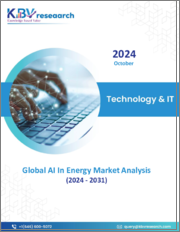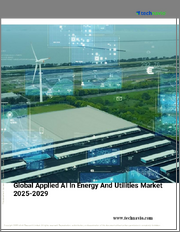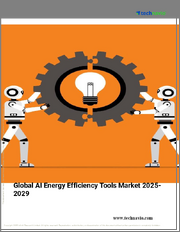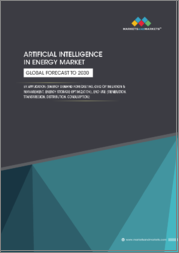
|
시장보고서
상품코드
1584915
세계의 에너지 분야 AI 시장 : 시장 규모, 점유율, 동향 분석 보고서 - 유형별, 용도별, 지역별 전망 및 예측(2024-2031년)Global AI In Energy Market Size, Share & Trends Analysis Report By Type (Solutions and Services), By Application, By Regional Outlook and Forecast, 2024 - 2031 |
||||||
세계 에너지 분야 AI 시장 규모는 예측 기간 동안 29.5%의 CAGR로 성장하여 2031년까지 656억 달러에 달할 것으로 예상됩니다.
KBV Cardinal Matrix에 제시된 분석에 따르면 Microsoft Corporation과 Google LLC는 AI In Energy 시장의 선구자이며 Amazon Web Services, Inc. 2024년 10월, 구글은 원자력발전 개발업체인 카이로스 파워(Kairos Power)와 제휴하여 2035년까지 500메가와트 규모의 AI 운영을 지원하기 위한 소형 모듈형 원자로를 개발했습니다. 이 파트너십은 AI 기술의 증가하는 수요를 충족하기 위해 에너지 원을 다양화하고 구글의 야심찬 AI 이니셔티브에 신뢰할 수 있고 지속가능한 전력 공급을 보장하는 것을 목표로 합니다.
시장 성장요인
기후변화와 그 악영향에 대한 인식이 높아짐에 따라 개인, 기업, 정부는 지속가능성을 우선순위로 삼고 있습니다. 청정에너지원과 온실가스 배출량 감축을 추구하면서 에너지 생산과 소비 방식에 근본적인 변화가 일어나고 있으며, AI 기술은 비효율성을 식별하고 프로세스를 최적화하여 에너지 회사가 수익성을 유지하면서 지속가능성 목표를 달성할 수 있도록 돕습니다. 달성할 수 있도록 돕습니다.
또한, 기후변화의 영향이 점점 더 뚜렷해지고 있으며, 허리케인, 홍수, 산불, 폭염 등 이상기후가 빈번하게 발생하고 있습니다. 이러한 현상은 에너지 공급에 심각한 혼란을 초래하고 그리드의 무결성을 손상시킬 수 있습니다. 그 결과, 에너지 공급업체들은 인프라의 복원력을 강화하는 기술에 투자할 수밖에 없습니다. 따라서 그리드 복원력 및 재해복구 솔루션에 대한 수요가 증가하면서 시장 성장을 견인하고 있습니다.
시장 억제요인
에너지 생산 및 관리에 AI 솔루션을 도입하려면 많은 경우 상당한 선행 투자가 필요합니다. 이러한 투자에는 고급 하드웨어, 소프트웨어 라이선스, 시스템 통합, 새로운 기술의 운영 및 유지보수를 위한 인력 교육 관련 비용이 포함됩니다. 많은 에너지 기업, 특히 소규모 기업들은 필요한 자금을 할당하는 데 어려움을 겪고 있으며, 이는 AI 솔루션을 도입하는 능력을 제한할 수 있습니다. 따라서 높은 초기 투자 비용과 경제적 타당성에 대한 우려로 인해 시장 성장에 걸림돌이 되고 있습니다.
시장의 주요 기업들은 시장에서 경쟁력을 유지하기 위해 다양하고 혁신적인 제품으로 경쟁하고 있습니다. 위 그림은 시장의 주요 기업 중 일부가 공유하는 수익의 비율을 보여줍니다. 시장의 주요 기업들은 다양한 산업의 수요를 충족시키기 위해 다양한 전략을 채택하고 있습니다. 시장의 주요 개발 전략은 파트너십과 협업입니다.
유형별 전망
유형에 따라 시장은 솔루션과 서비스로 구분되며, 2023년에는 서비스 부문이 시장에서 30%의 매출 점유율을 차지할 것으로 예상됩니다. 이 부문에는 조직이 AI 기술을 효과적으로 채택하고 통합 할 수 있도록 공급업체가 제공하는 컨설팅, 구현 및 지원 서비스가 포함됩니다.
용도 전망
용도에 따라 시장은 로봇 공학, 재생에너지 관리, 수요 예측, 안전 보안 및 인프라 등으로 분류됩니다. 2023년 재생에너지 관리 부문은 시장에서 28%의 매출 점유율을 기록했습니다. 이 부문은 AI 기술을 활용하여 태양광 및 풍력과 같은 재생에너지 원의 통합 및 관리를 최적화하는 데 중점을 두고 있습니다.
지역 전망
지역별로 보면 북미, 유럽, 아시아태평양, 라틴아메리카, 중동 및 아프리카, 유럽 지역이 2023년 시장에서 30%의 매출 점유율을 차지할 것으로 분석됐습니다. 유럽 시장은 재생에너지로의 전환과 온실가스 감축을 위한 적극적인 정책이 특징입니다. 유럽 국가들은 이러한 전환을 촉진하기 위해 AI 기술에 많은 투자를 하고 있으며, 재생에너지 관리, 수요 예측, 에너지 효율 최적화 등의 용도에 집중하고 있습니다.
에너지 분야 AI는 급속한 혁신과 지속가능한 에너지 솔루션에 대한 관심이 높아지면서 에너지 관리, 그리드 자동화, 수요 예측을 위한 효율적이고 확장 가능한 AI 기반 솔루션 개발에 대한 경쟁이 치열하게 전개되고 있습니다. 시장 참여자들은 경쟁 우위를 확보하기 위해 파트너십, R&D, 규제 준수를 우선시하는 한편, 에너지 시스템에 AI 통합을 간소화하는 사용자 친화적인 플랫폼에 중점을 두고 있습니다.
목차
제1장 시장 범위와 조사 방법
- 시장 정의
- 목적
- 시장 범위
- 세분화
- 조사 방법
제2장 시장 요람
- 주요 하이라이트
제3장 시장 개요
- 소개
- 개요
- 시장 구성과 시나리오
- 개요
- 시장에 영향을 미치는 주요 요인
- 시장 성장 촉진요인
- 시장 성장 억제요인
- 시장 기회
- 시장 과제
제4장 경쟁 분석 - 세계
- KBV Cardinal Matrix
- 최근 업계 전체의 전략적 전개
- 파트너십, 협업 및 계약
- 제품 발매와 제품 확대
- 인수와 합병
- 시장 점유율 분석 2023
- 주요 성공 전략
- 주요 전략
- 주요 전략적 활동
- Porter's Five Forces 분석
제5장 세계 시장 : 유형별
- 세계의 솔루션 시장 : 지역별
- 세계의 서비스 시장 : 지역별
제6장 세계 시장 : 용도별
- 세계의 재생에너지 관리 시장 : 지역별
- 세계의 수요 예측 시장 : 지역별
- 세계의 로봇 시장 : 지역별
- 세계의 안전·보안·인프라 시장 : 지역별
- 세계의 기타 용도 시장 : 지역별
제7장 세계 시장 : 지역별
- 북미
- 북미의 시장 : 국가별
- 미국
- 캐나다
- 멕시코
- 기타 북미
- 북미의 시장 : 국가별
- 유럽
- 유럽의 시장 : 국가별
- 독일
- 영국
- 프랑스
- 러시아
- 스페인
- 이탈리아
- 기타 유럽
- 유럽의 시장 : 국가별
- 아시아태평양
- 아시아태평양의 시장 : 국가별
- 중국
- 일본
- 인도
- 한국
- 싱가포르
- 말레이시아
- 기타 아시아태평양
- 아시아태평양의 시장 : 국가별
- 라틴아메리카, 중동 및 아프리카
- 라틴아메리카, 중동 및 아프리카 시장 : 국가별
- 브라질
- 아르헨티나
- 아랍에미리트
- 사우디아라비아
- 남아프리카공화국
- 나이지리아
- 기타 라틴아메리카, 중동 및 아프리카
- 라틴아메리카, 중동 및 아프리카 시장 : 국가별
제8장 기업 개요
- Siemens AG
- ABB Group
- Schneider Electric SE
- GE Vernova Group
- Hitachi, Ltd
- Honeywell International, Inc
- Amazon Web Services, Inc(Amazon.com, Inc.)
- Google LLC
- Microsoft Corporation
- AutoGrid Systems, Inc
제9장 에너지 분야 AI 성공 필수 조건
ksm 24.11.15The Global AI In Energy Market size is expected to reach $65.6 billion by 2031, rising at a market growth of 29.5% CAGR during the forecast period.
As the energy industry continues to evolve and embrace automation, the robotics segment is expected to grow significantly, driven by the need for innovative solutions to address complex energy management and infrastructure development challenges. Thus, in 2023, the robotics forecasting segment held 21% revenue share in the AI in energy market. Robotics applications in the energy sector are becoming increasingly prevalent, focusing on automating tasks that enhance operational efficiency and safety. For instance, robotic systems can conduct inspections, perform maintenance on infrastructure, and facilitate the deployment of renewable energy technologies. By integrating AI with robotics, energy companies can achieve higher accuracy in operations, reduce labour costs, and minimize risks associated with human error in hazardous environments.
The major strategies followed by the market participants are Partnership as the key developmental strategy to keep pace with the changing demands of end users. For instance, In October, 2024, Honeywell International has teamed up with Chevron, a leading energy company, to develop advanced AI-assisted solutions aimed at enhancing refining operations. This collaboration will introduce new alarm management technologies that guide operators in decision-making, improving efficiency, safety, and reliability within industrial automation. The integration of AI into Honeywell's Experion(R) distributed control system will help address workforce shortages and enhance operational effectiveness, marking a significant step forward in refining processes and industry innovation. Additionally, In October, 2024, Amazon Web Services partnered with Dominion Energy, a leading utility company, to explore the use of small modular reactors for powering data centers. This collaboration aims to enhance clean electricity sourcing amid surging demand for AI and data processing.
Based on the Analysis presented in the KBV Cardinal matrix; Microsoft Corporation and Google LLC are the forerunners in the AI In Energy Market. Companies such as Amazon Web Services, Inc., Siemens AG, Schneider Electric SE are some of the key innovators in AI In Energy Market. In October, 2024, Google has partnered with Kairos Power, a nuclear power developer, to develop small modular reactors aimed at supporting its AI operations with a target of 500 megawatts by 2035. This partnership seeks to diversify energy sources to meet the increasing demands of AI technologies, ensuring a reliable and sustainable power supply for Google's ambitious AI initiatives.
Market Growth Factors
Growing awareness of climate change and its adverse impacts has prompted individuals, corporations, and governments to prioritize sustainability. The quest for cleaner energy sources and reduced greenhouse gas emissions has led to a fundamental shift in how energy is produced and consumed. AI technologies are instrumental in identifying inefficiencies and optimizing processes, enabling energy companies to meet sustainability targets while maintaining profitability.
Additionally, the impacts of climate change are becoming more evident, with extreme weather events such as hurricanes, floods, wildfires, and heat waves occurring more frequently. These events can severely disrupt the energy supply and compromise the integrity of the grid. As a result, energy providers are compelled to invest in technologies that enhance the resilience of their infrastructure. Thus, the rising need for grid resilience and disaster recovery solutions propels the market's growth.
Market Restraining Factors
Implementing AI solutions in energy production and management often requires substantial upfront capital investments. These investments encompass costs related to advanced hardware, software licenses, system integration, and the training of personnel to operate and maintain new technologies. Many energy companies, particularly smaller players, may find it challenging to allocate the necessary funds, limiting their ability to adopt AI solutions. Therefore, high initial investment costs and economic viability concerns hamper the market's growth.
The leading players in the market are competing with diverse innovative offerings to remain competitive in the market. The above illustration shows the percentage of revenue shared by some of the leading companies in the market. The leading players of the market are adopting various strategies in order to cater demand coming from the different industries. The key developmental strategies in the market are Partnerships & Collaborations.
Type Outlook
On the basis of type, the market is segmented into solutions and services. In 2023, the services segment attained 30% revenue share in the market. This segment includes consulting, implementation, and support services vendors provide to help organizations adopt and integrate AI technologies effectively.
Application Outlook
Based on application, the market is categorized into robotics, renewable energy management, demand forecasting, safety security & infrastructure, and others. In 2023, the renewable energy management segment registered 28% revenue share in the market. This segment focuses on utilizing AI technologies to optimize integrating and managing renewable energy sources, such as solar and wind power.
Regional Outlook
Region-wise, the is analyzed across North America, Europe, Asia Pacific, and LAMEA. In 2023, the Europe region generated 30% revenue share in the market. The European market is characterized by aggressive policies to transition to renewable energy sources and reduce greenhouse gas emissions. Countries across Europe invest heavily in AI technologies to facilitate this transition, focusing on applications such as renewable energy management, demand forecasting, and energy efficiency optimization.
The AI in energy market is highly competitive, driven by rapid innovation and an increasing focus on sustainable energy solutions. Key attributes include advanced analytics, predictive maintenance, and energy optimization, enabling companies to reduce costs and carbon emissions. Competition revolves around developing efficient, scalable AI-driven solutions for energy management, grid automation, and demand forecasting. Market players prioritize partnerships, R&D, and regulatory compliance to secure a competitive edge, as well as user-friendly platforms that simplify AI integration in energy systems.
Recent Strategies Deployed in the Market
- Oct-2024: Honeywell International has teamed up with Chevron, a leading energy company, to develop advanced AI-assisted solutions aimed at enhancing refining operations. This collaboration will introduce new alarm management technologies that guide operators in decision-making, improving efficiency, safety, and reliability within industrial automation. The integration of AI into Honeywell's Experion(R) distributed control system will help address workforce shortages and enhance operational effectiveness, marking a significant step forward in refining processes and industry innovation.
- Oct-2024: Honeywell International is collaborating with Qualcomm Technologies, Inc., a leader in semiconductors, to develop AI-enabled solutions for the energy sector. This partnership will integrate Qualcomm's connectivity products and AI chipsets into Honeywell's applications, enhancing operational efficiency and real-time feedback. The initiative aims to support industrial digital transformation, improve efficiencies, and facilitate automation, leveraging intelligent handheld devices and low power wireless sensors to monitor critical systems and enhance decision-making.
- Oct-2024: Hitachi, Ltd. has launched the R2O2.ai framework through its subsidiary, Hitachi Digital Services, aimed at building and scaling trustworthy AI solutions. This framework enables enterprises to efficiently deploy AI models that enhance operational efficiency and reduce downtime. By leveraging over 20 years of AI expertise, R2O2.ai addresses critical industry challenges, positioning Hitachi to deliver responsible AI solutions for sustainable energy and other sectors.
- Oct-2024: Honeywell International has introduced AI-enabled solutions to enhance efficiency in the energy sector. By integrating AI technologies like Honeywell Forge, the company aims to optimize plant operations and accelerate the workforce's path to autonomy. Honeywell's new offerings include the Experion Operations Assistant, which uses explainable AI to assist operators in addressing production issues. This initiative aligns with the growing demand for intelligent solutions to improve productivity and address workforce challenges in the energy industry.
- Oct-2024: Amazon Web Services partnered with Dominion Energy, a leading utility company, to explore the use of small modular reactors for powering data centers. This collaboration aims to enhance clean electricity sourcing amid surging demand for AI and data processing.
- Oct-2024: Google has partnered with Kairos Power, a nuclear power developer, to develop small modular reactors aimed at supporting its AI operations with a target of 500 megawatts by 2035. This collaboration seeks to diversify energy sources to meet the increasing demands of AI technologies, ensuring a reliable and sustainable power supply for Google's ambitious AI initiatives.
List of Key Companies Profiled
- Siemens AG
- ABB Group
- Schneider Electric SE
- GE Vernova Group
- Hitachi, Ltd
- Honeywell International Inc.
- Amazon Web Services, Inc. (Amazon.com, Inc.)
- Google LLC
- Microsoft Corporation
- AutoGrid Systems, Inc.
Global AI In Energy Market Report Segmentation
By Type
- Solutions
- Services
By Application
- Renewable Energy Management
- Demand Forecasting
- Robotics
- Safety Security & Infrastructure
- Other Application
By Geography
- North America
- US
- Canada
- Mexico
- Rest of North America
- Europe
- Germany
- UK
- France
- Russia
- Spain
- Italy
- Rest of Europe
- Asia Pacific
- China
- Japan
- India
- South Korea
- Singapore
- Malaysia
- Rest of Asia Pacific
- LAMEA
- Brazil
- Argentina
- UAE
- Saudi Arabia
- South Africa
- Nigeria
- Rest of LAMEA
Table of Contents
Chapter 1. Market Scope & Methodology
- 1.1 Market Definition
- 1.2 Objectives
- 1.3 Market Scope
- 1.4 Segmentation
- 1.4.1 Global AI In Energy Market, by Type
- 1.4.2 Global AI In Energy Market, by Application
- 1.4.3 Global AI In Energy Market, by Geography
- 1.5 Methodology for the research
Chapter 2. Market at a Glance
- 2.1 Key Highlights
Chapter 3. Market Overview
- 3.1 Introduction
- 3.1.1 Overview
- 3.1.1.1 Market Composition and Scenario
- 3.1.1 Overview
- 3.2 Key Factors Impacting the Market
- 3.2.1 Market Drivers
- 3.2.2 Market Restraints
- 3.2.3 Market Opportunities
- 3.2.4 Market Challenges
Chapter 4. Competition Analysis - Global
- 4.1 KBV Cardinal Matrix
- 4.2 Recent Industry Wide Strategic Developments
- 4.2.1 Partnerships, Collaborations and Agreements
- 4.2.2 Product Launches and Product Expansions
- 4.2.3 Acquisition and Mergers
- 4.3 Market Share Analysis, 2023
- 4.4 Top Winning Strategies
- 4.4.1 Key Leading Strategies: Percentage Distribution (2020-2024)
- 4.4.2 Key Strategic Move: (Partnerships, Collaborations and Agreements: 2023, Jul - 2024, Oct) Leading Players
- 4.5 Porter Five Forces Analysis
Chapter 5. Global AI In Energy Market by Type
- 5.1 Global Solutions Market by Region
- 5.2 Global Services Market by Region
Chapter 6. Global AI In Energy Market by Application
- 6.1 Global Renewable Energy Management Market by Region
- 6.2 Global Demand Forecasting Market by Region
- 6.3 Global Robotics Market by Region
- 6.4 Global Safety Security & Infrastructure Market by Region
- 6.5 Global Other Application Market by Region
Chapter 7. Global AI In Energy Market by Region
- 7.1 North America AI In Energy Market
- 7.1.1 North America AI In Energy Market by Type
- 7.1.1.1 North America Solutions Market by Country
- 7.1.1.2 North America Services Market by Country
- 7.1.2 North America AI In Energy Market by Application
- 7.1.2.1 North America Renewable Energy Management Market by Country
- 7.1.2.2 North America Demand Forecasting Market by Country
- 7.1.2.3 North America Robotics Market by Country
- 7.1.2.4 North America Safety Security & Infrastructure Market by Country
- 7.1.2.5 North America Other Application Market by Country
- 7.1.3 North America AI In Energy Market by Country
- 7.1.3.1 US AI In Energy Market
- 7.1.3.1.1 US AI In Energy Market by Type
- 7.1.3.1.2 US AI In Energy Market by Application
- 7.1.3.2 Canada AI In Energy Market
- 7.1.3.2.1 Canada AI In Energy Market by Type
- 7.1.3.2.2 Canada AI In Energy Market by Application
- 7.1.3.3 Mexico AI In Energy Market
- 7.1.3.3.1 Mexico AI In Energy Market by Type
- 7.1.3.3.2 Mexico AI In Energy Market by Application
- 7.1.3.4 Rest of North America AI In Energy Market
- 7.1.3.4.1 Rest of North America AI In Energy Market by Type
- 7.1.3.4.2 Rest of North America AI In Energy Market by Application
- 7.1.3.1 US AI In Energy Market
- 7.1.1 North America AI In Energy Market by Type
- 7.2 Europe AI In Energy Market
- 7.2.1 Europe AI In Energy Market by Type
- 7.2.1.1 Europe Solutions Market by Country
- 7.2.1.2 Europe Services Market by Country
- 7.2.2 Europe AI In Energy Market by Application
- 7.2.2.1 Europe Renewable Energy Management Market by Country
- 7.2.2.2 Europe Demand Forecasting Market by Country
- 7.2.2.3 Europe Robotics Market by Country
- 7.2.2.4 Europe Safety Security & Infrastructure Market by Country
- 7.2.2.5 Europe Other Application Market by Country
- 7.2.3 Europe AI In Energy Market by Country
- 7.2.3.1 Germany AI In Energy Market
- 7.2.3.1.1 Germany AI In Energy Market by Type
- 7.2.3.1.2 Germany AI In Energy Market by Application
- 7.2.3.2 UK AI In Energy Market
- 7.2.3.2.1 UK AI In Energy Market by Type
- 7.2.3.2.2 UK AI In Energy Market by Application
- 7.2.3.3 France AI In Energy Market
- 7.2.3.3.1 France AI In Energy Market by Type
- 7.2.3.3.2 France AI In Energy Market by Application
- 7.2.3.4 Russia AI In Energy Market
- 7.2.3.4.1 Russia AI In Energy Market by Type
- 7.2.3.4.2 Russia AI In Energy Market by Application
- 7.2.3.5 Spain AI In Energy Market
- 7.2.3.5.1 Spain AI In Energy Market by Type
- 7.2.3.5.2 Spain AI In Energy Market by Application
- 7.2.3.6 Italy AI In Energy Market
- 7.2.3.6.1 Italy AI In Energy Market by Type
- 7.2.3.6.2 Italy AI In Energy Market by Application
- 7.2.3.7 Rest of Europe AI In Energy Market
- 7.2.3.7.1 Rest of Europe AI In Energy Market by Type
- 7.2.3.7.2 Rest of Europe AI In Energy Market by Application
- 7.2.3.1 Germany AI In Energy Market
- 7.2.1 Europe AI In Energy Market by Type
- 7.3 Asia Pacific AI In Energy Market
- 7.3.1 Asia Pacific AI In Energy Market by Type
- 7.3.1.1 Asia Pacific Solutions Market by Country
- 7.3.1.2 Asia Pacific Services Market by Country
- 7.3.2 Asia Pacific AI In Energy Market by Application
- 7.3.2.1 Asia Pacific Renewable Energy Management Market by Country
- 7.3.2.2 Asia Pacific Demand Forecasting Market by Country
- 7.3.2.3 Asia Pacific Robotics Market by Country
- 7.3.2.4 Asia Pacific Safety Security & Infrastructure Market by Country
- 7.3.2.5 Asia Pacific Other Application Market by Country
- 7.3.3 Asia Pacific AI In Energy Market by Country
- 7.3.3.1 China AI In Energy Market
- 7.3.3.1.1 China AI In Energy Market by Type
- 7.3.3.1.2 China AI In Energy Market by Application
- 7.3.3.2 Japan AI In Energy Market
- 7.3.3.2.1 Japan AI In Energy Market by Type
- 7.3.3.2.2 Japan AI In Energy Market by Application
- 7.3.3.3 India AI In Energy Market
- 7.3.3.3.1 India AI In Energy Market by Type
- 7.3.3.3.2 India AI In Energy Market by Application
- 7.3.3.4 South Korea AI In Energy Market
- 7.3.3.4.1 South Korea AI In Energy Market by Type
- 7.3.3.4.2 South Korea AI In Energy Market by Application
- 7.3.3.5 Singapore AI In Energy Market
- 7.3.3.5.1 Singapore AI In Energy Market by Type
- 7.3.3.5.2 Singapore AI In Energy Market by Application
- 7.3.3.6 Malaysia AI In Energy Market
- 7.3.3.6.1 Malaysia AI In Energy Market by Type
- 7.3.3.6.2 Malaysia AI In Energy Market by Application
- 7.3.3.7 Rest of Asia Pacific AI In Energy Market
- 7.3.3.7.1 Rest of Asia Pacific AI In Energy Market by Type
- 7.3.3.7.2 Rest of Asia Pacific AI In Energy Market by Application
- 7.3.3.1 China AI In Energy Market
- 7.3.1 Asia Pacific AI In Energy Market by Type
- 7.4 LAMEA AI In Energy Market
- 7.4.1 LAMEA AI In Energy Market by Type
- 7.4.1.1 LAMEA Solutions Market by Country
- 7.4.1.2 LAMEA Services Market by Country
- 7.4.2 LAMEA AI In Energy Market by Application
- 7.4.2.1 LAMEA Renewable Energy Management Market by Country
- 7.4.2.2 LAMEA Demand Forecasting Market by Country
- 7.4.2.3 LAMEA Robotics Market by Country
- 7.4.2.4 LAMEA Safety Security & Infrastructure Market by Country
- 7.4.2.5 LAMEA Other Application Market by Country
- 7.4.3 LAMEA AI In Energy Market by Country
- 7.4.3.1 Brazil AI In Energy Market
- 7.4.3.1.1 Brazil AI In Energy Market by Type
- 7.4.3.1.2 Brazil AI In Energy Market by Application
- 7.4.3.2 Argentina AI In Energy Market
- 7.4.3.2.1 Argentina AI In Energy Market by Type
- 7.4.3.2.2 Argentina AI In Energy Market by Application
- 7.4.3.3 UAE AI In Energy Market
- 7.4.3.3.1 UAE AI In Energy Market by Type
- 7.4.3.3.2 UAE AI In Energy Market by Application
- 7.4.3.4 Saudi Arabia AI In Energy Market
- 7.4.3.4.1 Saudi Arabia AI In Energy Market by Type
- 7.4.3.4.2 Saudi Arabia AI In Energy Market by Application
- 7.4.3.5 South Africa AI In Energy Market
- 7.4.3.5.1 South Africa AI In Energy Market by Type
- 7.4.3.5.2 South Africa AI In Energy Market by Application
- 7.4.3.6 Nigeria AI In Energy Market
- 7.4.3.6.1 Nigeria AI In Energy Market by Type
- 7.4.3.6.2 Nigeria AI In Energy Market by Application
- 7.4.3.7 Rest of LAMEA AI In Energy Market
- 7.4.3.7.1 Rest of LAMEA AI In Energy Market by Type
- 7.4.3.7.2 Rest of LAMEA AI In Energy Market by Application
- 7.4.3.1 Brazil AI In Energy Market
- 7.4.1 LAMEA AI In Energy Market by Type
Chapter 8. Company Profiles
- 8.1 Siemens AG
- 8.1.1 Company Overview
- 8.1.2 Financial Analysis
- 8.1.3 Segmental and Regional Analysis
- 8.1.4 Research & Development Expense
- 8.1.5 Recent strategies and developments:
- 8.1.5.1 Partnerships, Collaborations, and Agreements:
- 8.1.5.2 Product Launches and Product Expansions:
- 8.1.5.3 Acquisition and Mergers:
- 8.1.6 SWOT Analysis
- 8.2 ABB Group
- 8.2.1 Company Overview
- 8.2.2 Financial Analysis
- 8.2.3 Segmental and Regional Analysis
- 8.2.4 Research & Development Expense
- 8.2.5 Recent strategies and developments:
- 8.2.5.1 Partnerships, Collaborations, and Agreements:
- 8.2.6 SWOT Analysis
- 8.3 Schneider Electric SE
- 8.3.1 Company Overview
- 8.3.2 Financial Analysis
- 8.3.3 Segmental and Regional Analysis
- 8.3.4 Research & Development Expense
- 8.3.5 Recent strategies and developments:
- 8.3.5.1 Partnerships, Collaborations, and Agreements:
- 8.3.5.2 Product Launches and Product Expansions:
- 8.3.6 SWOT Analysis
- 8.4 GE Vernova Group
- 8.4.1 Company Overview
- 8.4.2 Recent strategies and developments:
- 8.4.2.1 Acquisition and Mergers:
- 8.4.3 SWOT Analysis
- 8.5 Hitachi, Ltd.
- 8.5.1 Company Overview
- 8.5.2 Financial Analysis
- 8.5.3 Segmental and Regional Analysis
- 8.5.4 Research & Development Expenses
- 8.5.5 Recent strategies and developments:
- 8.5.5.1 Partnerships, Collaborations, and Agreements:
- 8.5.5.2 Product Launches and Product Expansions:
- 8.5.6 SWOT Analysis
- 8.6 Honeywell International, Inc.
- 8.6.1 Company Overview
- 8.6.2 Financial Analysis
- 8.6.3 Segmental and Regional Analysis
- 8.6.4 Research & Development Expenses
- 8.6.5 Recent strategies and developments:
- 8.6.5.1 Partnerships, Collaborations, and Agreements:
- 8.6.5.2 Product Launches and Product Expansions:
- 8.6.6 SWOT Analysis
- 8.7 Amazon Web Services, Inc. (Amazon.com, Inc.)
- 8.7.1 Company Overview
- 8.7.2 Financial Analysis
- 8.7.3 Segmental Analysis
- 8.7.4 Recent strategies and developments:
- 8.7.4.1 Partnerships, Collaborations, and Agreements:
- 8.7.5 SWOT Analysis
- 8.8 Google LLC
- 8.8.1 Company Overview
- 8.8.2 Financial Analysis
- 8.8.3 Segmental and Regional Analysis
- 8.8.4 Research & Development Expense
- 8.8.5 Recent strategies and developments:
- 8.8.5.1 Partnerships, Collaborations, and Agreements:
- 8.8.6 SWOT Analysis
- 8.9 Microsoft Corporation
- 8.9.1 Company Overview
- 8.9.2 Financial Analysis
- 8.9.3 Segmental and Regional Analysis
- 8.9.4 Research & Development Expenses
- 8.9.5 Recent strategies and developments:
- 8.9.5.1 Partnerships, Collaborations, and Agreements:
- 8.9.5.2 Acquisition and Mergers:
- 8.9.6 SWOT Analysis
- 8.10. AutoGrid Systems, Inc.
- 8.10.1 Company Overview


















